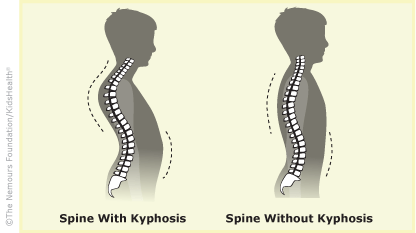Kyphosis Factsheet (for Schools)
What Teachers Should Know
Kyphosis is a forward rounding of the spine. A normal spine has a certain amount of upper back kyphosis. Abnormal kyphosis is an exaggerated rounding, which often occurs in the upper and middle part of the back. The condition is evaluated and treated by orthopedic health care providers.

Mild kyphosis usually isn't visible, doesn't cause any other problems, and doesn't need medical treatment. Larger curves look like a hunched back or poor posture. The curvature can be painful. In severe cases, it might cause problems with breathing or weakness or numbness in the legs.
Kids and teens with severe kyphosis often need physical therapy. Some kids with severe kyphosis may need a back brace, and a few might need surgery. Those who do have surgery usually can resume an active lifestyle after treatment.
Students with kyphosis might:
- if they need a back brace, feel embarrassed about wearing a it to school
- miss a lot of class time if they need surgery (up to a month)
- need extra time to complete assignments and make up tests
- benefit from having a 504 education plan that calls for seating accommodations and extra time getting to and from classes
- need to visit the school nurse for pain medicine
- need to be excused from or accommodated for physical education and sports
- be at risk for bullying
What Teachers Can Do
Kyphosis does not affect students' ability to learn, but it can affect the quality of their lives.
You can support them by encouraging their participation in the activities they can do and being understanding about any pain or fatigue they might feel in the classroom.


